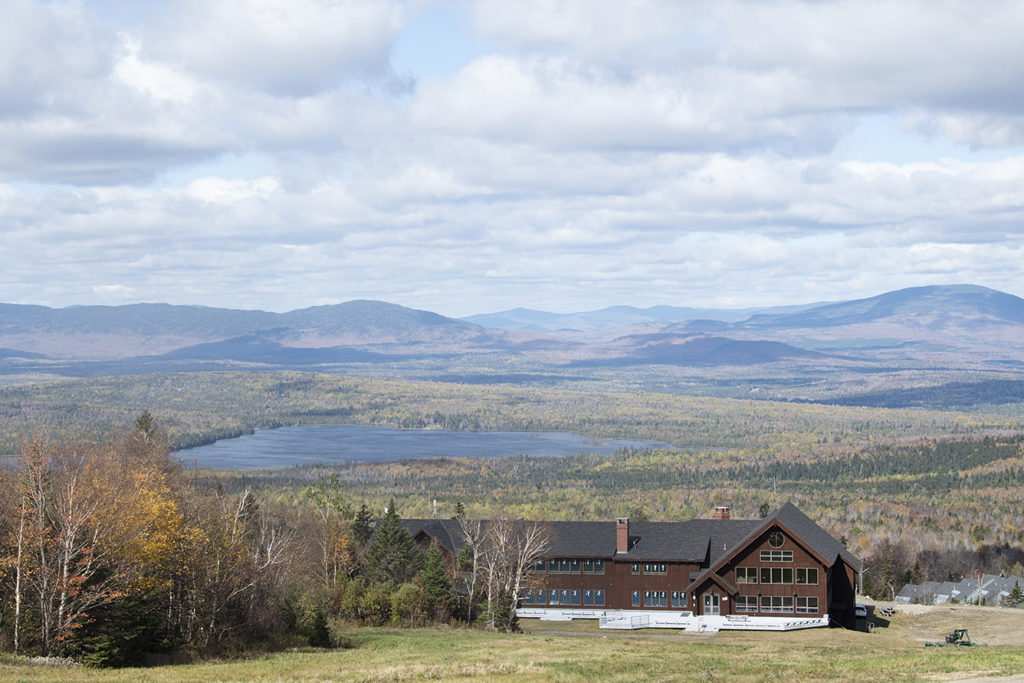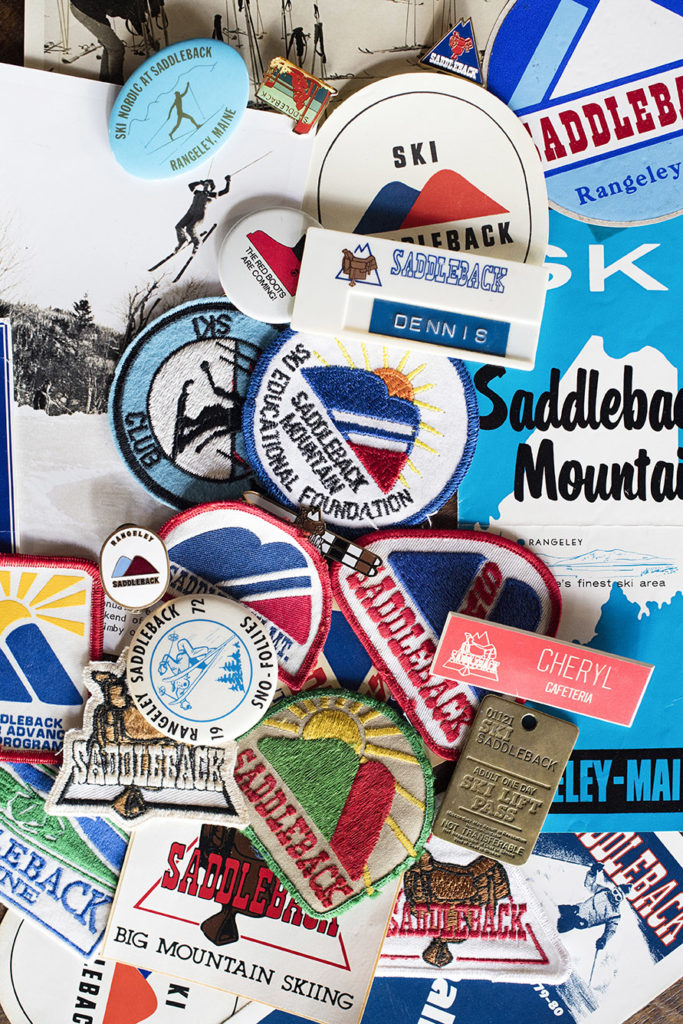Comeback Mountain

Comeback Mountain
After a five-year hiatus, Saddleback Mountain is ready to open, with a new chairlift and ambitious plans for the future.
by Anna Fiorentino
Photography by Nicole Wolf
Issue: December 2020
It’s a toss-up, Jimmy Quimby tells me, between the day in 2003 when Saddleback Mountain hired him and last January when, in the final hour and after years of failed and fraudulent attempts, Maine’s third-largest ski area sold for $6.5 million to Boston-based Arctaris Impact Fund. Those are the moments that define his lifetime on the mountain.
When the Rangeley ski resort reopens this winter, it will be the first time Quimby, who is one of just two employees who worked at Saddleback through its entire five-year closure, has skied at all since the mountain halted operations in 2015. “I’m prideful, I guess. I wouldn’t ski anywhere else,” he says. “I can’t wait to ski on my own mountain again.” Quimby, the director of mountain operations, is decked out in camouflage and bright orange powersports gear that now doubles as a face mask. Like many locals in Rangeley’s year-round population of 1,100, Quimby has a loyalty to the mountain that runs as deep as his love for hunting and fishing. Saddleback Mountain, which first opened in 1960, has been around almost as long as Quimby has been alive, but it’s turned a profit just three of those years.

Yet, in the land of snowmobiles and ATVS, and despite its rocky past, this old-fashioned ski area has remained a staple of the community. “In town I get asked every day, ‘Are you really going to open that ski area?’ Well, heck yeah, we’re gonna open it,” Quimby says. “We just bought a $6.8 million lift. We busted our rear ends to get this place running.”
When the COVID-19 pandemic hit, Saddleback reaped the benefits of other ski resorts closing early and suspending summer projects. Arctaris Impact Fund was first in line for a long-overdue detachable quad chairlift, a snowcat, and major upgrades to the base lodge, and the resort got to handpick staff who’d been laid off by other ski areas.

The goal of the impact fund—now the only one in the country that owns a ski resort—is to revitalize low- and moderate-income communities like Rangeley. Over the next eight years, Arctaris plans to invest $38 million in expanding snowmaking capabilities, building a second, mid-mountain lodge, and adding five additional chairlifts, to total eight lifts. The firm intends to create more than 200 jobs and affordable housing to make Rangeley not only a place with extraordinary natural resources, but also an economically viable place for more people to live. “Thank goodness for Arctaris, because I don’t think we would have made it another year,” says Quimby.
I join Quimby in Saddeback’s unofficial museum, his small chalet-style home on the access road. He’s curated a treasure trove of hundreds of pins, posters, original patches, and ancient, skinny wooden demo skis. When you think the ship is going down, you save whatever you can.
Just like Quimby’s, my earliest memory of any ski resort is of Saddleback. When I was seven, my dad’s hockey buddy invited our family to stay at his mountainside condo. Things were going pretty well on the bunny slope until I took a chairlift up and realized it wasn’t going to be a joy ride back to the bottom. The instructor carried me the whole way down between his legs. On the third run, I hit the shed at the bottom of the hill.

Old-school straight skis from Quimby’s collection. 
Jared Emerson, mountain manager, joined Saddleback’s ski patrol at age 16. 
Views abound from the top of the mountain’s first detachable quad chairlift.
It turns out Quimby’s grandfather had helped build that shed in 1960, the year the mountain opened. Quimby’s uncle laid the access road, and his mother worked in the cafeteria. His father, Richard Quimby, helped a local contractor construct the mountain’s first chairlift, the longest in Maine at the time. One day in 1963 Richard Quimby got into an argument with that boss—“expletives were exchanged,” Jimmy Quimby says—and he walked off the job. There at the bottom of the mountain stood Nick Frost, representing a group of vacationers who had put Rangeley on the map for fly-fishing and had formed Rangeley-Saddleback Corporation to make Rangeley a four-season destination. Frost hired Richard Quimby right there on the spot to finish the chairlift.
But, without snow or snowmaking, Saddleback folded after a few seasons. Those fluke mild winters marked the beginning of a long line of trials and tribulations for the not-so-little mountain that could not catch a break.
The exception was during Saddleback’s heyday, from the mid-’60s to early ’70s, when Suzy Chaffee jumpsuits were in full effect and it was owned by Richard “Dick” Arnzen of Guy Gannett Publishing. Things went downhill for subsequent owners until 2003, when a retired geology professor from the University of Maine at Farmington named Bill Berry sunk his family inheritance into Saddleback. “Bill Berry’s family is one of the finest I’ve met in my life,” says Quimby. Berry’s Saddleback attracted crowds, “but what killed us after 12 years was that old 1963 chairlift,” he adds. The family closed the ski area in 2015 after a loan to replace the lift fell through in the eleventh hour.

Kayaks at Rangeley Lake. 
Decades worth of stickers, pins, photos, and patches from Quimby’s collection.
As the failed ski area drew herds of backcountry skiers, potential buyers began presenting lopsided community development plans and outlandish schemes. The Australia-based Majella Group was in the process of buying Saddleback in 2018 when its CEO was arrested for alleged investment fraud. “He was going to build an eight-mile gondola from town to the top of Saddleback, and a 12-story glass high-rise out in the valley,” says Quimby. “You get starstruck, until you realize this guy is full of crap.”
Next summer, with Arctaris in charge, Saddleback’s new mid-mountain lodge will be a model for alpine development, with an undulating sod roof that will grow native low-bush blueberries. It will blend into the environment from above and feed the area’s rare birds, including the Bicknell’s thrush. “Rather than pouring a cement slab and plopping a warehouse on top, we’ll build pillars for minimal disruption of the watershed. The glass will be insulated and glare-resistant, with a treatment to reduce bird strikes,” says Saddleback CEO and general manager Andy Shepard. (Shepard, a former L.L.Bean executive, almost bought the mountain years ago on behalf of Maine Winter Sports Center, now Outdoor Sport Institute.) The resort is also planning a new sugar shack and will offer uphill skiing, mountain and fat biking, paddling, and photography and plein-air painting classes, along with amenities for Appalachian Trail hikers.

I hitch a ride in a souped-up ATV with Jared Emerson, Quimby’s right-hand man, and we head up Saddleback’s new and first-ever dirt road to the summit. I watch hikers on the AT sinking poles into the wild green. Lakes anchor the 360-degree views of Maine’s western mountains, Canada, Mount Washington, and Katahdin. These are the sights that make Saddleback Saddleback. The horn of the saddle at 4,012 feet—lofty by the standards of the East, making this the second-highest elevation of any ski area in Maine—overlooks 66 trails on 6,400 acres of terrain.
“When a storm hits, the mountain stalls it, so we collect all the snow it has to offer,” explains Emerson from behind the wheel of the ATV. He tells me he also grew up on Saddleback, spending some nights in the parking lot in his grandfather’s truck camper so they could hit the slopes early. He joined the ski patrol at age 16 and was promoted to director of ski patrol in 2006, at the age of 22. Now mountain manager, Emerson is as loyal to the town of Rangeley as he is to his boss; he and Quimby have always been loyal to the mountain. “Jared was working at the power equipment store downtown the day Arctaris bought Saddleback,” Quimby says. “I called him and said, ‘Dude, it’s on. We just sold.’ He walked out, drove up the mountain, and we drank a beer.” Eventually, Quimby will pass his collection of Saddeback memorabilia on to Emerson, but on opening day Quimby will be the one smiling the whole way down his first run in five long years.

